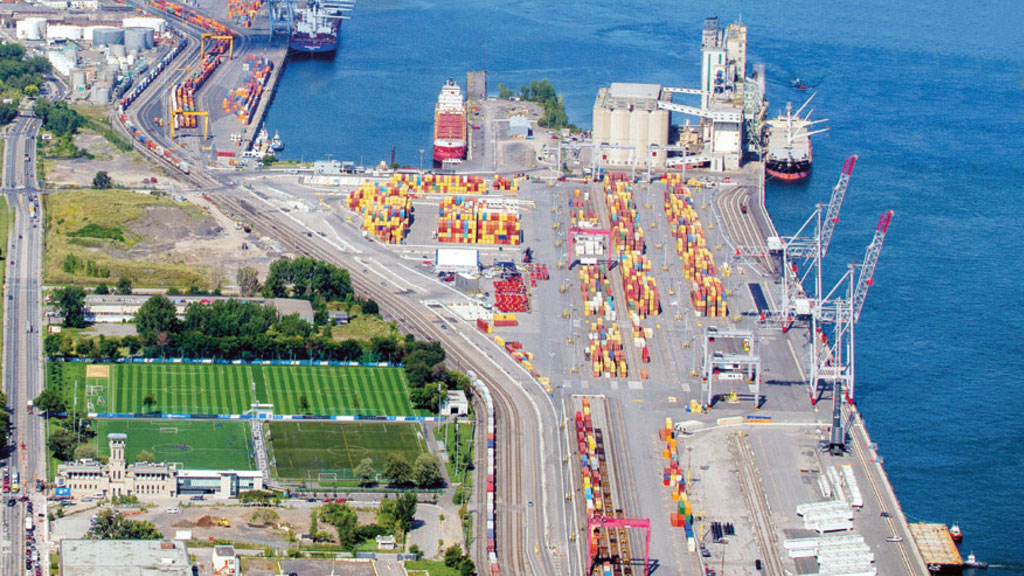The Montreal Port Authority (MPA) is continuing rigorous preparation and planning work for a $950-million Contrecoeur terminal expansion project on the south shore of the St. Lawrence River.
The project will increase the capacity of the port and include a 675-metre-long dock, rail network and freight transfer hub, container handling yard and operations and administrative buildings.
Upon completion, the terminal will have two berths, an intermodal marshalling yard connected to the main rail system, a truck gate connected to the road network, and secondary facilities for port activities.
The venue — the largest container port in Eastern Canada — will launch a request for proposals (RFP) to select a private partner to build the land-side components of the terminal by this summer. A schedule is expected to be released once the outcome of the RFP is known.
The Constructeurs Terminal de Contrecoeur Grand Projet consortium, consisting of Pomerleau and Aecon, was selected to do the design of the in-water works for the expansion project. The group is designing marine infrastructure such as quays, breakwaters, dredging and embankments.
A collaborative design-build approach is being used, which means the contractor and builder will work closely together throughout the development phase to finalize the design and arrive at an estimated schedule and cost for the project works.
Such an approach is being increasingly used for major infrastructure projects as it offers better efficiency and co-ordination and provides greater predictability on costs and deadlines.
Design of the project, along with an estimated schedule and cost of the work, will take place this year.
“We are proud to be a part of the Port of Montreal’s expansion project in Contrecoeur, which will enable the MPA to realize its innovative vision for the country’s shipping industry,” says Pomerleau president and CEO Philippe Adam. “We applaud the use of the progressive design-build model, which prioritizes transparency and teamwork between prime contractor and designer and ensures better planning and sound risk management.”
The terminal is expected to be in service by late 2026.
The project will increase the total capacity of the port by 55 per cent.
Some critical milestones in the project have already been reached.
For example, land has been secured and extensive geotechnical surveying has been completed. Pre-design work has been completed and there has been a thorough public consultation process via outreach events.
The port also received a decision from the minister of environment and climate change in March 2021 in favour of the Contrecoeur project. The decision set out some 387 implementation conditions, which cover environmental and social issues, and which often require the participation of First Nations. Some have already been put in place while others will be implemented.
For example, steps are being taken to protect Bank Swallows, the Western chorus frog, various species of vulnerable bats, the copper redhorse fish, as well as forest habitats and wetlands.
The new container terminal will encroach on one hectare of the adult copper redhorse’s feeding grounds.
The port authority, in partnership with a number of other organizations, is planning a number of measures including the creation of habitats conducive to aquatic grass beds.
The port project will also include various technical measures designed to ensure access to carbon-neutral facilities as soon as the new terminal begins operation. The long-term goal is to operate an emissions-free container terminal.
Among these initiatives, the use of electrical port equipment and wharf electrification will serve to reduce greenhouse gas emissions.
So far, the federal government has kicked in $150 million for the project under the National Trade Corridors Fund. In 2021, the Quebec government committed $55 million and in spring 2023 announced another $75 million. The province also recently announced up to $16.75 million to add a fourth track on the Pie-IX railway bridge and building a storage area.
The project will strengthen modal interconnectivity at the port, ensure the safety of rail operations on the site, and help to reduce environmental impacts by using rail freight over trucking.
A study released recently by Martin Associates found in 2022, 36 million tonnes of goods were transported through the port, generating 5,181 direct, induced and indirect jobs, and $208.1 million in federal, provincial and local tax impacts.
Factoring in all port activities, the industry supports 154,774 jobs for importers and exporters, contributing $19.8 billion to the economy.
Over the past 45 years, the port has grown from handling 750 Twenty-foot Equivalent Units (TEUs) to more than 6,000 TEUs. The new container terminal will have a capacity of 1.15 million TEUs and allow the port to generate up to $140 million per year in activity across the country.






Recent Comments